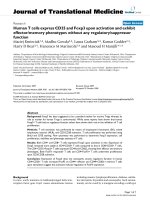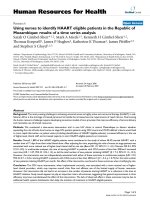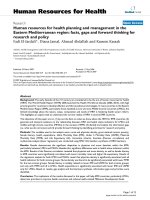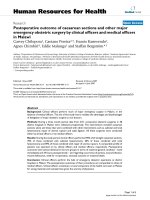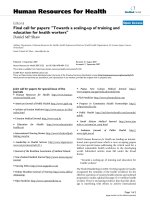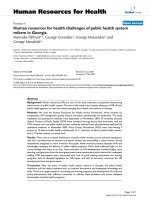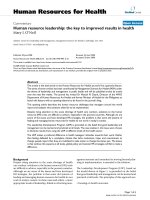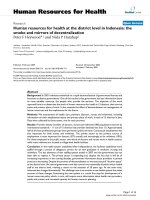báo cáo sinh học:" Human resources for health planning and management in the Eastern Mediterranean region: facts, gaps and forward thinking for research and policy" pot
Bạn đang xem bản rút gọn của tài liệu. Xem và tải ngay bản đầy đủ của tài liệu tại đây (316.07 KB, 12 trang )
BioMed Central
Page 1 of 12
(page number not for citation purposes)
Human Resources for Health
Open Access
Research
Human resources for health planning and management in the
Eastern Mediterranean region: facts, gaps and forward thinking for
research and policy
Fadi El-Jardali*, Diana Jamal, Ahmad Abdallah and Kassem Kassak
Address: Health Management and Policy Department, Faculty of Health Sciences, American University of Beirut, Lebanese Republic
Email: Fadi El-Jardali* - ; Diana Jamal - ; Ahmad Abdallah - ;
Kassem Kassak -
* Corresponding author
Abstract
Background: The early decades of the 21
st
century are considered to be the era of human resources for health
(HRH). The World Health Report (WHR) 2006 launched the Health Workforce Decade (2006–2015), with high
priority given for countries to develop effective workforce policies and strategies. In many countries in the Eastern
Mediterranean Region (EMR), particularly those classified as Low and Low-Middle Income Countries (LMICs), the
limited knowledge about the nature, scope, composition and needs of HRH is hindering health sector reform.
This highlights an urgent need to understand the current reality of HRH in several EMR countries.
The objectives of this paper are to: (1) lay out the facts on what we know about the HRH for EMR countries; (2)
generate and interpret evidence on the relationship between HRH and health status indicators for LMICs and
middle and high income countries (MHICs) in the context of EMR; (3) identify and analyze the information gaps
(i.e. what we do not know) and (4) provide forward thinking by identifying priorities for research and policy.
Methods: The variables used in the analysis were: nurse and physician density, gross national income, poverty,
female literacy, health expenditure, Infant Mortality Rate (IMR), Under 5 Mortality Rate (U5MR), Maternal
Mortality Rate (MMR) and Life Expectancy (LE). Univariate (charts), bivariate (Pearson correlation) and
multivariate analysis (linear regression) was conducted using SPSS 14.0, besides a synthesis of HRH literature.
Results: Results demonstrate the significant disparities in physician and nurse densities within the EMR,
particularly between LMICs and MHICs. Besides this, significant differences exist in health status indicators within
the EMR. Results of the Pearson correlation revealed that physician and nurse density, as well as female literacy
in EMR countries were significantly correlated with lower mortality rates and higher life expectancy. Results of
the regression analysis for both LMICs and MHICs reveal that physician density is significantly associated with all
health indicators for both income groups. Nurse density was found to be significantly associated with lower MMR
for the two income groups. Female literacy is notably related to lower IMR and U5MR for both income groups;
and only with MMR and LE in LMICs. Health expenditure is significantly associated with lower IMR and U5MR
only for LMICs. Based on results, gap analysis and the literature synthesis, information gaps and priorities were
identified.
Conclusion: The implication of the results discussed in this paper will help EMR countries, particularly LMICs,
determine priorities to improve health outcomes and achieve health-related Millenium Development Goals.
Published: 23 March 2007
Human Resources for Health 2007, 5:9 doi:10.1186/1478-4491-5-9
Received: 11 May 2006
Accepted: 23 March 2007
This article is available from: />© 2007 El-Jardali et al; licensee BioMed Central Ltd.
This is an Open Access article distributed under the terms of the Creative Commons Attribution License ( />),
which permits unrestricted use, distribution, and reproduction in any medium, provided the original work is properly cited.
Human Resources for Health 2007, 5:9 />Page 2 of 12
(page number not for citation purposes)
Background
The early decades of the 21
st
century are considered to be
the era of human resources for health (HRH). The health
care sector is both labour-intensive and labour-reliant,
and the delivery of quality health care services is strongly
dependent on having enough well-trained health care
workers to meet patient needs and expectations. The
World Health Organization (WHO) estimates the current
HRH workforce at 59 million and its global shortage at
4.3 million [1]. Health workers are defined as "people
engaged in actions whose primary intent is to enhance
health" [1]. The World Health Report (WHR), 2006,
launched the Health Workforce Decade (2006–2015),
with high priority given for countries to develop effective
workforce strategies that include three core elements:
improving recruitment, helping the existing workforce
perform better, and slowing down the rate at which work-
ers leave the health workforce. The report emphasized
HRH management and planning as major strategic prior-
ities for achieving this goal with its three core elements.
At the global level, many countries are facing critical HRH
challenges including worker shortage, skill-mix imbal-
ance, maldistribution, poor work environment, and weak
knowledge base [2-4]. In several Low and Low-Middle
Income countries (LMICs), the supply of health profes-
sionals is being challenged by demographic trends; an
aging population; growing shortages; limited education
and training capacities; poor recruitment and retention
strategies including out-migration of health professionals;
skill-mix imbalance; maldistribution; poor HRH plan-
ning; absence of a reliable database; poorly informed pol-
icy decisions [2,5]; and slow health system reform [5]. In
Table 1, we highlight key global HRH challenges that are
also relevant to LMICs.
The HRH challenges listed in Table 1 mostly affect LMICs
that suffer from poor health outcomes, such as rising
death rates and decreasing life expectancies at birth [2].
This is critical in the context of the Eastern-Mediterranean
Region (EMR), where the World Bank classified most
(61%) of its 22 countries as Low or Low-Middle Income
Countries [6]. In addition, EMR has the second lowest
HRH density (per 1000 population), right after Africa,
among the six administrative regions of the WHO (See
Table 2) [1]. Evidence from several research studies shows
that health worker density is directly correlated with pop-
ulation-based health indicators such as Maternal Mortal-
ity Rate (MMR), Infant Mortality Rate (IMR) and Under-5
Mortality Rate (U5MR) [7,8]. While these studies used
global data to test the relationship between worker's den-
sity and health outcome indicators, none has used the
most recent data to test this relationship in LMICs versus
Middle and High Income countries (MHICs). While HRH
density might be equally important for both LMICs and
MHICs, examining the relationship for each of these two
groups is critical for determining priorities for these coun-
tries to improve health outcomes and achieve the Millen-
nium Development Goals (MDG).
Currently, many EMR countries are either implementing
health reform plans or in the process of doing so. Evi-
dence suggests that successful health system reform in any
country depends on the provision of effective, efficient,
assessable, sustainable and high quality services by a
health workforce that is sufficient in number, appropri-
ately-trained and equitably-distributed [9]. For several
EMR countries, a limited understanding of HRH issues,
challenges and priorities may hinder sustainable health
sector reform [2,10]. Many developed countries have
researched the nature and scope of HRH planning and
management, particularly its problems, needs, gaps and
impacts on health status. Yet for many EMR countries,
almost nothing is known. This highlights an urgent need
to understand the current reality of HRH in the EMR. In
this paper, we make use of the most recent and available
data (both global and regional) to generate and analyze
evidence on HRH in the context of EMR. HRH in EMR is
an underdeveloped field where evidence base has to be
established. This paper will help several EMR countries
determine priorities for improving population health out-
comes; one of those priorities is HRH.
Study objectives
The objectives of this paper are to:
1. lay out the facts on what we know about the HRH in
EMR countries;
2. generate and interpret evidence on the relationship
between HRH and health status indicators for LMICs and
MHICs in the context of EMR;
3. identify and analyze the knowledge gaps;
4. provide forward thinking by identifying priorities for
research and policy.
The first objective will be achieved using univariate and
bivariate (Pearson correlation) analysis of the most recent
regional data for the 22 EMR countries. The second objec-
tive will be realized through multivariate analysis tech-
niques (linear regression) of the most recent global data.
The remaining two objectives will be achieved by review-
ing and analyzing published HRH literature in developed
and developing countries. This literature includes major
health reports on the EMR, published by researchers,
stakeholder organizations and agencies including the
WHO. To our knowledge, this study is among very few
research papers that investigate HRH issues and analyze
Human Resources for Health 2007, 5:9 />Page 3 of 12
(page number not for citation purposes)
and interpret the global HRH data in the context of the
EMR.
Methods
Study variables and sources
Our analysis comprises the following 5 independent vari-
ables:
1. Physician and nurse densities: they collectively account
for the majority of healthcare providers in most countries
[7];
2. Gross national income (GNI): it captures a multitude of
factors that affect mortality rates such as nutrition, access
to safe water, sanitation, housing, etc. [7];
3. Percentage of the population living below the poverty
line of $1 per day: higher poverty rates are associated with
higher mortality rates [7];
4. Female adult literacy: it is known to reflect behaviour
and lifestyle which in turn influence mortality rates [7];
5. Total expenditure on health: it represents the resources
spent on health, which may influence health outcomes
[11].
The dependent variables are: IMR; U5MR; MMR; and Life
expectancy (LE). These variables were selected since evi-
dence shows that they can be influenced by HRH densities
[1] and other socioeconomic factors. Data for both the
independent and dependent variables was retrieved from
the sources listed in Table 3.
Table 1: HRH challenges
Challenges for HRH Global LMICs
Health worker shortages (particularly nurses and physicians)
Poor working conditions and remuneration
Aging workforce
Recruitment and retention
Maldistribution & skill mix imbalance
Educational reform
Out-migration
Health human resources planning (future needs)
Absence of database on HRH
Worker's health and well-being
9 9
9 9
9 9
9 9
9 9
9 9
9 9
9 9
9 9
9 9
Table 2: Density of the global health workforce across WHO administrative regions
‡
Region Total health workforce
Number Density (per 1,000 population)
Africa 1 640 000 2.3
Eastern Mediterranean 2 100 000 4.0
South-East Asia 7 040 000 4.3
Western Pacific 10 070 000 5.8
Europe 16 630 000 18.9
Americas 21 740 000 24.8
World 59 220 000 9.3
‡
Adapted from WHR 2006, page 5
Human Resources for Health 2007, 5:9 />Page 4 of 12
(page number not for citation purposes)
Methods and Data Analysis
We generated knowledge on HRH in the EMR by using
data from twenty-two countries (Afghanistan, Bahrain,
Cyprus, Djibouti, Egypt, Iraq, Islamic Republic of Iran,
Jordan, Kuwait, Lebanon, Libyan Arab Jamahiriya,
Morocco, Oman, Pakistan, Qatar, Saudi Arabia, Somalia,
Sudan, Syrian Arab Republic, Tunisia, United Arab Emir-
ates and Yemen). Only univariate and bivariate (Pearson
Correlation) data analysis was performed for the EMR
data due to the limited number of cases (22 countries),
which does not allow the use of more advanced statistical
methods such as regression analysis. To overcome this, a
multivariate analysis technique was used to test the rela-
tionship between HRH and health status at the global
level (all world countries) and also for LMICs versus
MHICs. Countries, at a global level, were classified into
these two income groups (LMICs and MHICs) based on
the World Bank's (2005) income classification.
Data was regressed in three separate models: (1) at a glo-
bal level, (2) for LMICs and (3) for MHICs. Poverty was
dropped from all the regression models because the high
percentage of missing data for this variable did not allow
the models to hold (53% missing data at a global level,
38% for LMICs and 67% for MHICs). Since an initial anal-
ysis revealed a non-linear relationship between our
dependent and independent variables, we estimated all
regression equations within a log-linear functional form.
All statistical analysis was conducted using the Statistical
Package for Social Sciences (SPSS) 14.0.
Results
Results of the univariate data analysis indicate wide varia-
tions in terms of HRH density between the six administra-
tive WHO regions. In fact, compared to the other regions,
the EMR was found to have the second lowest HRH den-
sity (see Table 2). Even within the EMR itself, significant
disparities exist concerning physician and nurse densities
(see Figure 1). Of particular note is the high physician
density in Lebanon compared to both the global and EMR
averages. In fact, physician density in Lebanon is about
twice the nurse density. Qatar is at the other end of the
spectrum; its nurse density, the highest in the region, is
twice its physician density.
Significant differences also exist in health status indicators
within the (see Figure 2). Of particular interest are the
cases of Somalia and Afghanistan which were observed in
Figure 1 to have the lowest HRH densities in the region.
The IMR in these two countries is respectively twice and
thrice the regional and global averages; and their U5MR
was found to be approximately four and five times the
regional and global averages, respectively. This might be
attributed to the recent wars in these countries and may
not necessarily be a result of low HRH density. For this
reason, we removed both countries from our analysis.
While war conflicts exist in Iraq and Sudan as well, we did
not remove them from our analysis, since their mortality
rates are not as extreme as those of Afghanistan and Soma-
lia. In fact, these rates are even lower than some other
EMR countries that are not currently enduring war con-
flicts.
Results of the Pearson correlation revealed that physician
and nurse density, and female literacy in EMR countries
were significantly correlated with lower mortality rates
and higher life expectancy. However, poverty, income and
health expenditure were not significantly correlated with
health status indicators for EMR countries (See Table 4).
This latter finding runs opposite to other study findings
that used global data to test such relationships [7]. This
could be explained by the fact that the Pearson correlation
does not allow for controlling the effect of other variables.
While we were not able to perform regression analysis on
the EMR data due to the limited number of cases (22
countries), we made use of the global data to test the rela-
tionship between our selected variables.
Regression analysis of the global data revealed that physi-
cian density was significantly associated with all health
outcome indicators (see Table 5). The sign of the Beta (β)
value indicates that an increase in physician density is
Table 3: Sources of data used in this analysis
Variable Source
Dependant variables IMR World Fact Book 2005
U5MR World Health Report 2006
MMR World Health Report 2005
LE World Health Report 2006
Independent variables Physician density World Health Report 2006
Nurse density World Health Report 2006
Female literacy United Nations' Millennium Development Goals website
Income World Health Organization Statistical Information System
Poverty World Health Organization Statistical Information System
Health lxpenditure World Health Report 2006
Human Resources for Health 2007, 5:9 />Page 5 of 12
(page number not for citation purposes)
associated with a decrease in mortality rates and an
increase in LE. Increasing nurse density was only found to
be significantly associated with a decrease in both MMR
and LE. GNI was also significantly associated with
improvement in health status indicators. Neither total
health expenditure nor female literacy was significantly
associated with health outcome indicators at a global level
(see Table 5).
While the results from the global data analysis provide
evidence that HRH density and income are important pre-
dictors of population health status in all countries, it does
not provide evidence on whether such findings hold for
LMICs and MHICs. Therefore, we split the global data into
LMICs and MHICs and carried out the same analysis sep-
arately for each of those income groups. The importance
of such examination stems from the fact that 61% of the
22 EMR countries are classified as LMICs. Thus, EMR
country priorities might differ depending on its classifica-
tion as LMIC or MHIC.
Results of the regression analysis for both LMICs and
MHICs reveal that:
• Physician density is significantly associated with all
health outcome indicators for both income groups (See
Table 6); thus an increase in physician density would
result in improvement in IMR, U5MR, MMR and LE.
Distribution of physicians and nurses in the EMR*Figure 1
Distribution of physicians and nurses in the EMR*. *Data for nurse and physician density reflects: • 1997 estimates for
Libyan Arab Jamahiriya and Somalia. • 2001 for Afghanistan, Kuwait, Lebanon, Qatar, Syrian Arab Republic and United Arab
Emirates. • 2002 for Cyprus. • 2004 for Bahrain, Djibouti, Iraq, Islamic Republic of Iran, Jordan, Morocco, Oman, Pakistan, Saudi
Arabia, Sudan, Tunisia, and Yemen. • 2003 for Egypt's physician density and 2004 for nurse density.
0.00
0.50
1.00
1.50
2.00
2.50
3.00
3.50
4.00
4.50
5.00
Density in 1000s
Somalia
Afghanistan
Sudan
Yemen
Pakistan
Djibouti
Iran
Morocco
Egypt
Iraq
Tunisia
Syria
Jordan
Libya
Oman
Lebanon
Bahrain
Saudi Arabia
Kuwait
UAE
Qatar
Cyprus
EMR average
Global average
Low Income Low Middle Income Upper Middle
Income
High Income
Low and Middle Income Middle to High Income Averages
Physician density Nurse density
Human Resources for Health 2007, 5:9 />Page 6 of 12
(page number not for citation purposes)
• Nurse density, on the other hand, was only found to be
significantly related to lower MMR for both income
groups (see Table 6).
• Female literacy, which was not significant at the global
level (see Table 5), was found to be significant when data
was segregated according to income level. Female literacy
was associated with lower IMR and U5MR for both
income groups, and with MMR and LE for LMICs.
• Health expenditure, similar to female literacy, was not
significant at the global level. However, it was signifi-
cantly associated with lower IMR and U5MR only at the
level of LMICs.
It could thus be inferred that, in addition to physician and
nurse density, female literacy and health expenditure
improve health outcome indicators for LMICs. Such a
finding will help EMR countries, particularly LMICs, in
determining priorities to improve health outcomes and
achieve health-related MDG targets.
Discussion
Analysis of regional data revealed that LMICs in the EMR
have low nurse and physician density and poor IMR and
U5MR when compared to MHICs in the same region. At
face value, this might imply that poor health outcome
indicators for LMICs in EMR could be a product of their
low HRH densities. While this justification might seem
IMR (per 1000) and U5MR (per 1000) in the EMR*Figure 2
IMR (per 1000) and U5MR (per 1000) in the EMR*. *Data reflects: • 2005 estimates for IMR. • 2004 for U5MR.
0
50
100
150
200
250
300
per 1000 live births
Yemen
Sudan
Pakistan
Somalia
Afghanistan
Jordan
Tunisia
Syria
Egypt
Iran
Morocco
Iraq
Djibouti
Oman
Lebanon
Libya
Cyprus
Kuwait
Saudi Arabia
UAE
Bahrain
Qatar
EMR average
Global average
Low Income Low Middle Income Upper Middle
Income
High Income
Low and Middle Income Middle to High Income Averages
IMR U5MR
Human Resources for Health 2007, 5:9 />Page 7 of 12
(page number not for citation purposes)
Table 5: Full regression analysis for predicting the influence of physician and nurse density and other socioeconomic variables on IMR,
U5MR, MMR and LE at a global level
IMR U5MR MMR LE
Physician density -0.140* -0.248** -0.389** 0.103**
Nurse density 0.011 0.091 -0.207* -0.060**
Female literacy -0.219 -0.331 -0.212 0.048
Health expenditure as % of GDP -0.183 -0.031 -0.215 -0.030
Per capita gross national income (US$) -0.405** -0.515** -0.368** 0.048**
R
2
0.703** 0.784** 0.735** 0.709**
N 123 123 120 123
* p-value < 0.05
** p-value < 0.01
Table 4: Pearson correlations between HRH density and health indicators in EMR‡
IMR U5MR MMR LE
Physician density
r -0.695 -0.646 -0.605 0.661
Sig. 0.001 0.002 0.005 0.002
N 20202020
Nurse density
r -0.817 -0.794 -0.777 0.807
Sig. <0.000 1 <0.000 1 <0.000 1 <0.000 1
N 20202020
Female literacy*
r -0.740 -0.746 -0.781 0.677
Sig. <0.000 1 <0.000 1 <0.000 1 <0.000 1
N 20202020
Population living below poverty line€
r 0.479 0.579 0.723 -0.511
Sig. 0.276 0.173 0.067 0.241
N 7777
Per capita gross national income (US $)
¥
r -0.323 -0.370 -0.347 0.391
Sig. 0.282 0.213 0.245 0.186
N 13131313
Total expenditure on health
r -0.074 -0.118 -0.058 0.051
Sig. 0.755 0.619 0.807 0.830
N 20202020
‡ Afghanistan and Somalia were found to be outliers and were therefore removed from the analysis, thus the above table is based on 20 of the EMR
countries
* Data on Female literacy represents 1990 estimates for Djibouti, Iran, Lebanon, Libya, United Arab Emirates and Yemen; ad 2004 estimates for
Bahrain, Cyprus, Egypt, Iraq, Jordan, Kuwait, Morocco, Oman, Pakistan, Qatar, Saudi Arabia, Sudan, Syria, and Tunisia
€ Data on population living below poverty line reflects 1997 estimates for Jordan, 1998 for Iran and Yemen, 1999 for Libya and Oman, and 2000 for
Egypt and Syria
¥ Data on per capita gross national income reflects 2003 estimates
£ Data on Total Expenditure on Health reflects 2003 estimates
Human Resources for Health 2007, 5:9 />Page 8 of 12
(page number not for citation purposes)
reasonable, our discussion of the results below will reveal
that there are other key determinants of the poor health
outcomes.
Our results pertaining to the global data analysis provide
evidence that HRH density and income are important pre-
dictors of population health outcomes (IMR, U5MR,
MMR, and LE) in all countries. This finding is consistent
with the findings of other studies, which note that the
presence of appropriate medical personnel to perform
suitable medical interventions is significant for preventing
the death of mothers and infants [7]. As noted earlier on
our regression results, physician density is significantly
associated with all health status indicators in both LMICs
and MHICs. However, the lower beta (β) values for LMICs
might imply that there are other critical predictors that are
as important as the number of physicians in improving
health outcomes in LMICs (see Table 6). Nurse density is
found to be significantly associated with MMR in both
LMICs and MHICs and the lower β value might be inter-
preted in a way similar to that of physicians.
In contrast to the findings at the global level (see Table 5),
female literacy is found to be significantly associated with
health outcome indicators. In LMICs, female literacy has
more effect on IMR and U5MR than on MMR, as a
mother's behavior has a more pronounced effect on her
child's health [7]. This is demonstrated by the higher β
value for IMR and U5MR than MMR and LE (see Table 6).
The inverse relationship between female literacy and IMR
is in accordance with the findings of Kim and Moody
(1992) who found this relationship to be significant, par-
ticularly in developing countries [12].
Health expenditure is found to be significantly associated
with health status indicators at the global level (see Table
5). While evidence on the association between health
expenditure and health outcomes is not yet conclusive in
the literature, our data analysis reveals that health expend-
iture is significantly associated with IMR and U5MR only
in LMICs. This is of particular interest since Nixon and
Ulmann (2006) suggested that a small change in health
expenditure in developing countries has a bigger impact
on health outcomes than a similar change in developed
countries [13].
Hertz el al. (1994) documented the significant role of
socioeconomic factors in improving health outcomes.
Although nurse and physician density is critical, our find-
ings, particularly those for LMICs, indicate that paying
attention to socioeconomic factors such as female literacy
and health expenditure is equally important for improv-
ing health outcome indicators. This finding is important
for driving the performance of health systems and priority
programs to achieve health-related MDG targets in EMR
countries, particularly the LMICs.
Information gaps in EMR
To reach health-related MDG and improve the perform-
ance of health systems, our analysis of the HRH facts
(what we currently know from the available data) suggests
that many EMR countries need to increase the number of
Table 6: Full regression analysis for predicting the influence of physician and nurse density and other socioeconomic variables on IMR,
U5MR, MMR and LE in LMICs and MHICs at a global level
IMR U5MR MMR LE
Physician density
LMICs -0.177** -0.317** -0.400** 0.101**
MHICs -0.643** -0.792** -0.878** 0.186**
Nurse density
LMICs -0.026 0.044 -0.284*-0.034
MHICs -0.197 -0.238 -0.397*-0.032
Female literacy
LMICs -0.573** -0.689** -0.491* 0.088*
MHICs -4.277* -5.250* -5.051 0.344
Health expenditure as % of GDP
LMICs -0.433** -0.459* -0.348 0.023
MHICs 0.090 0.310 0.405 -0.069
R
2
LMICs 0.556** 0.636** 0.716** 0.615**
MHICs 0.584** 0.592** 0.485** 0.560**
N
LMICs 93 94 93 94
MHICs 46 46 43 46
* p-value < 0.05
** p-value < 0.01
Human Resources for Health 2007, 5:9 />Page 9 of 12
(page number not for citation purposes)
their health workforce and adequately invest in other
determinants of health, a measure that will help reduce
the existing gap between the EMR and more developed
regions of the world. Despite our findings confirming that
the health workforce is a key factor in achieving popula-
tion health goals, evidence in the literature shows that
countries should not only consider the numbers, but also
the management of their workforce in order to ensure
adequate responses to the health system's needs. Even in
those countries where the quantity of health workers is
sufficient, evidence in the literature suggests that poor
management of the existing health workforce will make it
difficult for these workers to offer the best quality services
in the most productive manner.
HRH in EMR is an underdeveloped field where it is essen-
tial to establish an evidence base. The Annual Report
(2004) of WHO Eastern Mediterranean Regional Office
emphasized the need for developing evidence-based
guidelines for national human resources policy making,
planning and management of HRH [14]. Work is in
progress by the EMR regional office; its efforts are chan-
nelled to map out HRH in many countries in the region.
National observatories have been established to monitor
HRH development and consequently formulate regional
strategies for improving HRH planning and management
[15].
To better-inform HRH policies and to guide actions in
terms of management and planning, essential informa-
tion is needed, beyond just health worker density and
health status indicators. Building on our data analysis
(what we know about HRH in the EMR) and drawing on
evidence on HRH from both developed and developing
countries, we discuss below the third objective of this
paper, which is to identify the information gaps (i.e. what
we do not know) on HRH in the EMR. The information
gaps are discussed in two main thematic areas: manage-
ment and planning. These areas are concurrent with the
10-year plan set out by WHO (2006) for countries to
improve management, recruitment and performance of
HRH. Table 7 summarizes information gaps in both of
these thematic areas.
Work conditions can be a push or a pull factor for health
workers. Heavy workloads, excessive overtime, inflexible
scheduling, safety hazards, poor management and few
opportunities for leadership and professional develop-
ment are among the push factors that result in poor
recruitment and retention of HRH, including attrition and
migration. Evidence shows that good work conditions
improve recruitment and retention, workers' health and
well-being, quality of care and patient safety, organiza-
tional performance as well as societal outcomes. The
impact of poor work conditions on recruitment and reten-
tion, worker's satisfaction, patient satisfaction, turnover
rate, quality of care, patient outcomes and health systems
performance is well-researched in developed countries
[16,17]. Yet for countries in the EMR, almost nothing is
known. In addition, no information is available on the
productivity of existing health workers in this region. Lit-
erature shows that HRH shortage is more complex than a
simple imbalance in supply and demand. Put simply, it is
not about more supply in the short term. It is rather about
effective management and better utilization of existing
health workers within their legislated scope of practice
[9,18]. Health care and medical knowledge are constantly
evolving, which requires a clear understanding and review
of existing scope of practice (i.e. the activities that health
workers are educated and authorized to perform)[19].
Such information is essential in order to optimize the uti-
lization of the existing health care workforce in the EMR,
and hence control the under-and over-utilization of
health workers.
In terms of HRH planning, there is limited supply-based
data (i.e. numbers are only available for some categories,
rather than all public health and community health work-
ers, social workers and others). Furthermore, there is also
a lack of needs-based data (i.e. the number that EMR
countries need, now and in the future, to meet population
health needs). Moreover, limited information is available
on demographics, employment practices (full time, part
time and casual), skill-mix, geographic distribution, as
well as trends of migration and attrition of HRH. Errors in
assembling an appropriate skill-mix can lead to clinical
errors and possibly adverse patient outcomes [19]. Com-
prehensive data on the characteristics of health workers is
therefore essential for planning, particularly at the level of
conducting simulation models. These models aim at
quantifying losses as well as determining how many new
health workers would need to be appointed to offset the
losses and estimate future needs.
Priorities for research
While the largest component of health care costs is labour,
our identification of the information gaps discussed ear-
lier shows that little is known about this issue in the EMR
countries. This represents an HRH paradox: the largest
expenditure item in a health budget is the least known
about in many Eastern-Mediterranean countries. For HRH
policies to be effective, they should be based on and/or
informed by evidence. To this end, there is an urgent need
to generate research on the health workforce in the EMR.
With the current HRH data that EMR countries have, basic
research questions essential for planning and manage-
ment cannot be answered. In regard to effective manage-
ment and utilization of existing health workers, some key
Human Resources for Health 2007, 5:9 />Page 10 of 12
(page number not for citation purposes)
research questions should be investigated and answered.
Some of these questions are:
᭜ How many and what type of health workers are cur-
rently available to deliver health care services in each of
the EMR countries?
᭜ What are the demographics of the existing HRH and
how are they geographically distributed?
᭜ How many health workers are required to do what,
how, for whom and under what circumstances?
᭜ How many new nurses, physicians and other healthcare
workers are required to ensure sufficient delivery of health
care services to meet the needs of the population over the
next ten years (WHO's 10-year plan)?
᭜ What is the right mix of health workers that can meet
the health needs of the population in a given EMR coun-
try?
᭜ What is known about safe-staffing, absenteeism and
turnover patterns in EMR countries and how do they affect
quality of care, patient outcomes and organizational per-
formance?
᭜ What were the retirement, immigration, emigration,
employment and practice patterns over the last ten years
or so?
᭜ How many healthcare workers are expected to be lost to
retirement, death and out-migration over the next ten
years?
Some of the above-listed questions are well researched in
developed countries; however, limited up-to-date infor-
mation exists for EMR countries, especially at the level of
quantity, distribution and capacities of existing HRH.
Hence, health workforce research is needed in EMR coun-
tries in order to:
᭜ develop a limited minimum dataset of HRH;
᭜ conduct simulation models to quantify losses due to
retirement, death and out-migration of HRH for the next
ten years or so;
᭜ determine how many new health workers would need
to be appointed to offset the gap (if any); and
᭜ determine how work conditions can be improved to
better-recruit and retain health workers.
There is an urgent need to establish a regional research
agenda, which includes feasible research questions
addressing HRH issues that will likely be a priority in the
EMR region two to five years from now. This period is cho-
sen as it reflects the time required for research develop-
ment and execution processes. In addition, a research
synthesis agenda is required in order to address HRH pri-
ority issues over the next six to twenty-four months. This
agenda recognizes the more immediate needs of policy
makers, decision makers and managers for accessible
summaries of existing HRH research evidence in the
shorter term. This measure would assist EMR countries in
developing and planning effective policies to educate,
train, recruit and retain their health workforce. Priorities
for research are summarized in Table 8.
Limitations
The World Health Report 2006, titled "Working Together
for Health," provides valuable data on many categories of
health workers [1]. In our study, we used only physicians
and nurses to represent HRH mainly because they account
for the majority of care providers in most countries [7].
Another reason for not using the other categories of health
workers is the large percentage of missing data, particu-
larly for the EMR (68.2% missing data for Midwives;
63.6% for Community workers; 50% for Environmental
and Public Health workers; 45.5% for Lab technicians,
Health Management and support workers; and 40.9% for
other categories of health workers) [1].
Table 7: Information gaps in terms of management and planning for HRH
Information gaps
Management and utilization of existing HRH - Recruitment and retention strategies
- Work conditions; training and employment characteristics, and performance
- Migration and attrition
- Scope of practice (underutilized or over-utilized)
HRH planning - Absence of reliable HRH data (supply and needs-based)
- No data numbers, gaps, losses, demographics, categories (types and skill-mix), and
distribution of HRH
- More comprehensive data on other categories of health workers
Human Resources for Health 2007, 5:9 />Page 11 of 12
(page number not for citation purposes)
Data on some variables in our analysis (U5MR, MMR, LE
and total expenditure on health) was initially retrieved
from the WHR 2005. However, after noting considerable
difference in comparison to data reported in the WHR
2006, we decided to use the more recent report to ensure
reliability. The publication of the WHR 2006 offered
newer, but significantly dissimilar, data than the previous
report. This is due to the fact that data for most countries
is estimated using regression equations and therefore, as
recommended by the WHO, should be interpreted with
caution. To illustrate, the WHR 2005 estimated the health
expenditure in Yemen at 3.7% in 2005 and 5.5% in 2006.
Lebanon's health spending as a percentage of GDP was
reportedly 11.5% in 2005; it dropped down to 10.2% in
2006 [1,20]. There was also a significant difference in LE
for some EMR countries. Of particular importance is the
case of UAE which had an overall LE of 73 in 2005 and 77
in 2006. Although some significant year-to-year changes
in the data did not lead to significant changes in our
results, this variation (i.e. between WHR 2005 and WHR
2006) does reflect a need for establishing more reliable
registries in EMR countries to collect and report actual
data rather than estimates.
Conclusion
The EMR has the second lowest HRH density when com-
pared to the other WHO regions. Results demonstrate sig-
nificant disparities in physician and nurse densities within
the EMR, particularly between LMICs and MHICs.
Besides, significant differences exist in health status indi-
cators within the said region.
Our results strongly confirm the importance of HRH and
other determinants in affecting health outcomes. An
implication of our results is that investing and pouring in
more money to increase the number of physicians and
nurses in EMR countries – particularly the LMICs – will be
less effective and, to a certain extent, wasted if not accom-
panied by dramatic investments in socioeconomic deter-
minants of health. This is the case as HRH cannot be
looked at in isolation from other equally important deter-
minants of health. Investing in HRH, in addition to
increasing health expenditure, expanding female educa-
tion and raising national income will help countries, par-
ticularly the LMICs, to achieve health-related MDG. There
are no shortcuts for achieving the health-related MDG.
For LMICs, health outcome indicators will get worse, not
better, if countries do not address HRH as an integral
component of their health reform programs.
Achieving the MDG will not occur unless there is a right
mix of health workforce with the right skills in the right
place at the right time. This means that essential informa-
tion beyond the mere numbers of nurses and physicians
in the EMR is required. More supply of health workers in
the short term may not be as effective as better-manage-
ment and utilization of the existing stock of health work-
ers in EMR countries, particularly the LMICs. For example,
improving the work conditions for the existing health
workforce can improve recruitment and retention, staff
and patient satisfaction, quality of care and patient out-
comes.
HRH issues in many EMR countries are not well
researched. This paper identifies basic questions for fur-
ther research. Health workforce research is needed in EMR
countries in order to generate evidence to inform policy
decisions, including the development of country-specific
HRH policies and strategies.
List of abbreviations in order of appearance in
text
HRH: Human Resources for Health
WHO: World Health Organization
WHR: World Health Report
LMICs: Low and Low-Middle Income Countries
EMR: Eastern Mediterranean Region
Table 8: Priorities for research in terms of management and planning for HRH
Priorities for research
Management and utilization of existing HRH - Employee characteristics and productivity
- Geographic distribution
- Safe-staffing and workload
- Absenteeism and turnover
- Research on attrition and migration patterns, causes, practices and consequences
HRH planning - Creating minimum database
- Research on HRH numbers, gaps, losses, demographics, categories and distribution
- New ways to improve data collection of stocks and flows of health workers for forecasting
- Develop forecasting tools (minimum database)
Publish with Bio Med Central and every
scientist can read your work free of charge
"BioMed Central will be the most significant development for
disseminating the results of biomedical research in our lifetime."
Sir Paul Nurse, Cancer Research UK
Your research papers will be:
available free of charge to the entire biomedical community
peer reviewed and published immediately upon acceptance
cited in PubMed and archived on PubMed Central
yours — you keep the copyright
Submit your manuscript here:
/>BioMedcentral
Human Resources for Health 2007, 5:9 />Page 12 of 12
(page number not for citation purposes)
MMR: Maternal Mortality Rate
IMR: Infant Mortality Rate
U5MR: Under 5 Mortality Rate
MHICs: Middle and High Income countries
GNI: Gross National Income
LE: Life Expectancy
SPSS: Statistical Package for Social Sciences
MDG: Millennium Development Goals
Competing interests
The author(s) declare that they have no competing inter-
ests.
Authors' contributions
FE made substantial contributions to the conception,
design as well as analysis and interpretation of results. DJ
made substantial contributions to acquisition, analysis of
data and interpretation of results. AA made contribution
to the acquisition of data and data analysis. KK made con-
tribution to the acquisition of data in addition to revising
the content of the paper. FE and DJ were involved in draft-
ing the manuscript and revising it for intellectual content.
Authors read and approved the final manuscript.
Acknowledgements
Special thanks to Mr. Rabih Soubra for his assistance in data compilation.
References
1. World Health Organization: Working Together for Health: The
World Health Report 2006. Geneva, Switzerland: World Health
Organization; 2006.
2. Chen L, Evans T, Anand S, Boufford JI, Brown H, Chowdhury M,
Cueto M, Dare L, Dussault G, Elzinga G, et al.: Human resources
for health: overcoming the crisis. Lancet 2004, 364:1984-1990.
3. Dussault G, Dubois CA: Human resources for health policies: a
critical component in health policies. Hum Resour Health 2003,
1:1.
4. Wyss K: An approach to classifying human resources con-
straints to attaining health-related Millennium Development
Goals. Hum Resour Health 2004, 2:11.
5. Wang Y, Collins C, Tang S, Martineau T: Health Systems Decen-
tralization and Human Resources Management in Low and
Middle Income Countries. Public Administration and Development
2002, 22:439-453.
6. World Bank: World Bank List of Economies (July 2005). [http:/
/www.iscb.org/pdfs/WorldBankClassificationList2005.pdf].
7. Anand S, Barnighausen T: Human resources and health out-
comes: cross-country econometric study. Lancet 2004,
364:1603-1609.
8. Robinson JJ, Wharrad H: The relationship between attendance
at birth and maternal mortality rates: an exploration of
United Nations' data sets including the ratios of physicians
and nurses to population, GNP per capita and female liter-
acy. J Adv Nurs 2001, 34:445-455.
9. El-Jardali F, Fooks C: An Environmental Scan of Current Views
on Health Human Resources in Canada: Identified Prob-
lems, Proposed Solutions and Gap Analysis. Toronto, Ontario:
Health Council of Canada; 2005.
10. Hongoro C, McPake B: How to bridge the gap in human
resources for health. Lancet 2004, 364:1451-1456.
11. International Organization for Standards: Health Informatics-
Health Indicators Conceptual Framework. 2004.
12. Kim K, Moody PM: More resources better health? A cross-
national perspective. Soc Sci Med 1992, 34:837-842.
13. Nixon J, Ulmann P: The relationship between health care
expenditure and health outcomes. Evidence and caveats for
a causal link. Eur J Health Econ 2006, 7:7-18.
14. WHO East Mediterranean Regional Office: The Work of the
WHO in the East Mediterranean Region: Annual Report of
the Regional Director. Cairo: World Health Organization; 2004.
15. WHO East Mediterranean Regional Office: The Work of the
WHO in the East Mediterranean Region: Annual Report of
the Regional Director. Cairo: World Health Organization; 2005.
16. Aiken LH, Clarke SP, Sloane DM, Sochalski J, Silber JH: Hospital
nurse staffing and patient mortality, nurse burnout, and job
dissatisfaction. JAMA 2002, 288:1987-1993.
17. O'Brien-Pallas L, Alksnis C, Wang S, Birch S, Tomblin Murphy G, Roy
FA, Sajan P: Early retirement among RNs: Estimating the size
of the problem in Canada. Longwoods Review 2003, 1:2-9.
18. Bloor K, Maynard A: Planning Human Resources in Health
Care: Towards an economic approach – An International
Comparative Review. Ottawa, Canada. Canadian Health Services
Research Foundation; 2003.
19. Baranek PM: A review of Scopes of Practice of Health Profes-
sions in Canada: A Balancing Act. Toronto, Ontario: Health
Council of Canada; 2005.
20. World Health Organization: The World Health Report 2005:
Make Every Mother and Child Count. Geneva, Switzerland:
World Health Organization; 2005.
